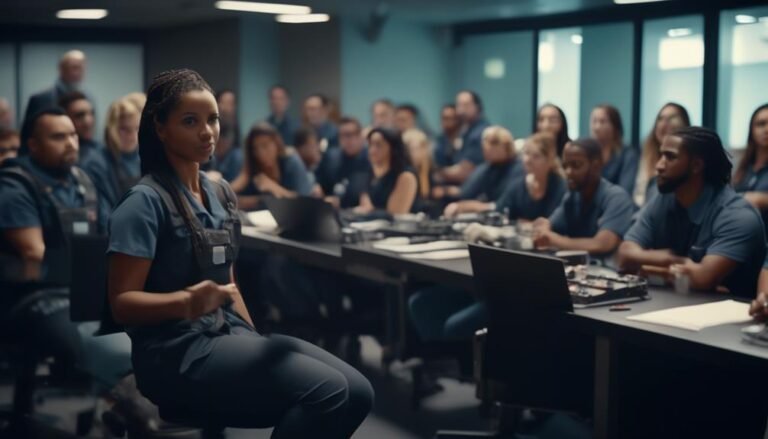Custom Content Development: Crafting Tailored Training Material
In today's ever-evolving professional landscape, the need for custom content development has become increasingly vital for organizations striving to enhance their training programs. Crafting tailored training material is not merely a matter of creating generic content with minor adjustments; it requires a meticulous understanding of the specific needs, learning objectives, and challenges within an organization.
Tailored content development involves a strategic approach to designing and delivering training materials that are not only engaging but also align with the organization's goals and the learners' needs. This process requires a careful blend of creativity, instructional design, and technological expertise to ensure that the training material is not only relevant but also impactful.
As the demand for personalized learning experiences continues to grow, the discussion on custom content development offers valuable insights into the best practices and strategies for creating effective training materials that resonate with today's workforce.
Key Takeaways
- Custom content development enhances online presence and engagement, allowing organizations to stand out and effectively communicate their message to their target audience.
- Tailored content facilitates personalized learning, enabling employees to receive training materials that are specifically designed to meet their individual needs and learning styles.
- Customized content boosts employee engagement by showing a commitment to their professional growth and development, leading to increased job satisfaction and productivity.
- Developing custom content that addresses specific skill gaps within the workforce ensures training effectiveness and maximizes the impact of training programs on overall organizational performance.
The Importance of Custom Content Development
Custom content development is essential for businesses looking to establish a unique and engaging online presence. The importance of tailored content cannot be overstated, especially in today's digital age where personalized learning and employee engagement are crucial for success.
By creating customized content, businesses can effectively cater to the specific needs and interests of their target audience, resulting in increased engagement and brand loyalty.
One of the key benefits of tailored content is its ability to facilitate personalized learning. When businesses develop content that is tailored to the individual preferences and learning styles of their audience, they can deliver a more impactful and effective learning experience. This, in turn, leads to higher levels of engagement and retention of the material.
Moreover, customized content also plays a significant role in boosting employee engagement. When businesses provide their employees with personalized training materials and resources, it demonstrates a commitment to their professional growth and development. This, in turn, fosters a sense of value and appreciation among employees, leading to higher levels of engagement and productivity within the organization.
Understanding Organizational Training Needs
Understanding organizational training needs involves conducting a thorough training needs analysis. This analysis helps identify skill gaps within the workforce. Once these skill gaps are identified, the next step is to develop performance improvement plans. These plans are crucial in ensuring that the training content developed is tailored to address the specific needs of the organization. By focusing on these aspects, custom content development can directly contribute to enhancing the overall effectiveness of the training programs.
Training Needs Analysis
Conducting a thorough analysis of an organization's training needs is crucial for developing effective and targeted training programs. To ensure training effectiveness, the needs assessment should encompass the following key aspects:
- Identifying Skill Gaps: Understanding the specific skills and knowledge gaps within the organization is essential to tailor training content that addresses these gaps effectively.
- Employee Feedback: Gathering input from employees regarding their perceived training needs and challenges can provide valuable insights for customizing training programs to meet their requirements.
- Organizational Goals Alignment: Aligning the training needs with the overall strategic goals of the organization ensures that the training programs contribute directly to the business objectives.
Skill Gap Identification
To ensure the effectiveness of training programs, a comprehensive understanding of an organization's skill gaps is essential for developing targeted and impactful content. Identifying these skill gaps involves a thorough assessment of the current capabilities of employees and a clear vision of the skills required to meet organizational goals. Addressing the skills gap is a critical aspect of training material development, as it allows for the creation of content that is specifically tailored to bridge the divide between existing competencies and the desired skill set. By focusing on the specific skills that need development, training materials can be designed to directly target these areas, maximizing the impact of the training program. The table below illustrates the importance of skill gap identification in training material development.
| Importance of Skill Gap Identification in Training Material Development | |
|---|---|
| Enables targeted content development | Bridges the divide between existing and required skills |
| Improves training program effectiveness | Aligns training content with organizational goals |
| Enhances employee performance | Ensures a return on training investment |
Performance Improvement Planning
An organization's performance improvement planning hinges on a comprehensive understanding of its specific training needs and objectives. This involves identifying areas where employee development is required and implementing strategies to enhance performance.
Key considerations for performance improvement planning include:
- Conducting a thorough assessment of current performance levels
- Identifying specific skill gaps and areas for improvement
- Developing targeted training programs to address the identified needs
Tailoring Content to Specific Learning Objectives
As we explore the topic of tailoring content to specific learning objectives, it is essential to consider the targeted learning outcomes, customized material design, and alignment with objectives.
These three key points form the foundation for creating custom content that effectively addresses the specific learning needs and goals of the organization.
Targeted Learning Outcomes
Developing custom content for targeted learning outcomes involves tailoring the material to specific learning objectives in order to ensure relevance and effectiveness. To achieve this, instructional design techniques play a crucial role in creating content that aligns with the desired learning outcomes.
This involves understanding the audience, their existing knowledge, and the desired end goals. By employing targeted learning outcomes, organizations can ensure that their training material is focused and directly addresses the skills and knowledge that learners need to acquire.
This targeted approach enhances the overall effectiveness of the training, leading to a more efficient use of resources and a higher return on investment.
- Understanding the audience's needs and existing knowledge
- Aligning content with desired end goals
- Enhancing effectiveness and efficiency through targeted learning outcomes
Customized Material Design
Tailoring content to specific learning objectives involves an intricate process of customizing material design in order to directly address the skills and knowledge that learners need to acquire.
Material customization is essential for meeting the diverse needs of learners and ensuring that the training material is relevant and effective.
Learning material personalization allows for the adaptation of content to suit different learning styles, preferences, and proficiency levels, thereby enhancing engagement and comprehension.
This customization may involve the use of varied media, interactive elements, real-life scenarios, and industry-specific examples to make the material more relatable and applicable to the learners' roles.
Alignment With Objectives
In custom content development, the alignment of the material with specific learning objectives is crucial for ensuring the relevance and effectiveness of training programs. Alignment with goals ensures that the content directly addresses the intended learning outcomes, maximizing the impact of the training.
Personalized learning approaches allow for the customization of content to meet the unique needs and preferences of the learners, enhancing engagement and knowledge retention. This tailored approach also supports the transfer of learning to real-world situations, as the content is directly relevant to the learners' roles and responsibilities.
Designing Engaging and Interactive Learning Materials
To create effective learning materials, it is essential to design content that captivates and engages the audience while promoting interactive participation.
Incorporating interactive exercises and engaging activities is crucial in ensuring that learners remain actively involved in the learning process. Visual learning plays a significant role in maintaining engagement, as it enhances comprehension and retention. Incorporating visual aids such as infographics, diagrams, and videos can significantly improve the overall learning experience.
In addition to visual learning, interactive simulations offer a dynamic way for learners to apply theoretical knowledge in practical scenarios. These simulations not only engage the learners but also provide an opportunity for them to test their understanding in a risk-free environment.
Furthermore, incorporating gamified elements into the learning materials can make the content more engaging. Gamification techniques such as points, badges, and leaderboards can motivate learners and promote healthy competition, thereby enhancing their overall learning experience.
Leveraging Technology for Custom Content Delivery
Incorporating technology into custom content development is a pivotal aspect of enhancing engagement and interactivity in learning materials. Leveraging technology allows for the creation of dynamic and interactive learning experiences, making the educational content more effective and enjoyable for the learners.
Here are some key ways technology can be leveraged for custom content delivery:
- Multimedia Integration: Incorporating videos, infographics, and audio clips into the learning materials can help in conveying information more effectively and engagingly.
- Interactive Assessments: Utilizing interactive quizzes, simulations, and games can provide immediate feedback to learners, enhancing their understanding and retention of the material.
- Mobile Learning Solutions: Developing custom content that is accessible on various devices such as smartphones and tablets allows for flexibility in learning, enabling learners to access the material anytime, anywhere.
Measuring the Impact of Custom Training Material
Measuring the impact of custom training material is essential for evaluating the effectiveness of the learning content and its contribution to the overall educational objectives. Measuring effectiveness involves assessing the extent to which the custom training material has influenced the learners' knowledge, skills, and behavior. Impact assessment encompasses various methods, including pre- and post-training evaluations, knowledge assessments, skills demonstrations, and feedback mechanisms. These measurements help in determining the tangible outcomes of the training, such as improved job performance, increased productivity, and enhanced decision-making abilities.
Additionally, impact assessment involves gathering qualitative data through surveys, interviews, and focus groups to understand the learners' perceptions of the training material and its applicability to their roles. This qualitative feedback provides valuable insights into the relevance and practicality of the custom content, allowing for adjustments and improvements to be made where necessary.
Furthermore, tracking key performance indicators (KPIs) before and after the training can provide quantitative evidence of the impact of the custom training material. By analyzing KPIs such as sales figures, customer satisfaction ratings, or error rates, organizations can directly correlate the training material with business outcomes.
Best Practices for Effective Custom Content Development
Effective custom content development is essential for delivering tailored and impactful learning experiences to meet the specific needs of learners. To ensure the development of high-quality custom content, it is crucial to follow best practices that promote effective engagement and interactive design.
Here are some key best practices to consider:
- Audience Analysis: Conduct a thorough analysis of the target audience to understand their learning preferences, prior knowledge, and specific needs. This will enable the creation of content that resonates with the learners and enhances their overall learning experience.
- Interactive Design: Incorporate interactive elements such as simulations, quizzes, and scenarios to promote active participation and engagement. Interactive design not only enhances learner retention but also provides a more immersive and engaging learning experience.
- Feedback Integration: Implement mechanisms for collecting feedback from learners during and after the training. This feedback can be used to continuously improve the custom content, ensuring that it remains effective and relevant to the learners' needs.
Conclusion
In conclusion, custom content development is essential for meeting the specific training needs of organizations. By tailoring training material to specific learning objectives and designing engaging and interactive content, organizations can ensure that their employees receive effective and impactful training.
Just as a tailor crafts a suit to fit an individual's unique measurements, custom content development creates training material tailored to the unique needs of an organization, resulting in better learning outcomes and improved performance.







